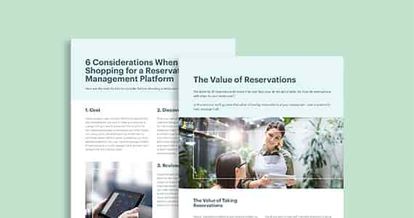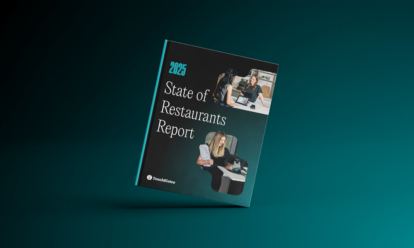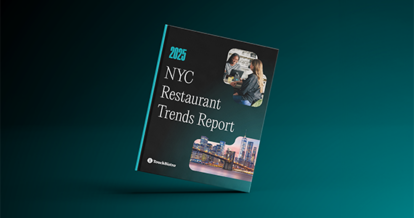In 2023, we saw the cost of goods sold stabilize a bit, however, labor costs remained high, and interest rates skyrocketed. No pandemic relief programs or tax bills were passed that would help reduce restaurant taxes, but there is still a lot you can do this tax season to mitigate taxes for your restaurant(s) and increase cash flow.
TouchBistro has enlisted the help of the experts at The Fork CPAs to help you head into tax season with a strategic cost-savings plan. Rather than simply help you organize your tax documents and understand the basics of how to file taxes for a restaurant, this article will provide a comprehensive roadmap for taking advantage of proven tax strategies and restaurant tax deductions to mitigate taxes and increase cash flow in your restaurant. These are the same strategies used by the seasoned accountants at The Fork CPAs to reduce taxes for hundreds of restaurants, both big and small.
By the time you’ve read our full restaurant tax guide, you’ll have:
- A list of important U.S. restaurant tax deadlines for 2024
- A breakdown of tax incentives and tax deductions for restaurant owners
- A step-by-step action plan for increasing restaurant cash flow during tax season
DISCLAIMER: This content is provided for informational purposes only. You are responsible for your own compliance with laws and regulations. Contact your attorney, accountant, or other relevant advisor for advice specific to your circumstances.
Important Deadlines for Restaurant Taxes in 2024
Before we jump into our comprehensive restaurant tax guide, we’ll start with summarizing the upcoming restaurant tax deadlines so you can plan accordingly.
January 31, 2024:
- 2023 Form 1099 filing
March 15, 2024:
- 2023 Federal Partnership tax return or extension
- 2023 S-corporation tax return or extension
March 31, 2024:
- 2023 Form 8027 for tipped establishments
April 15, 2024:
- 2023 Federal Individual tax returns or extension
- 2023 Federal C-corporation tax returns or extension
- 2024 Federal Q1 Individual tax estimated payments
June 15, 2024:
- 2024 Federal Q2 Individual tax estimated payments
September 16, 2024:
- Extended 2023 Federal Partnership tax return
- Extended 2023 S-corporation tax return
- 2024 Federal Q3 Individual tax estimated payments
October 15, 2024:
- Extended 2023 Federal Individual tax returns
- Extended 2023 Federal Corporation tax returns
April 15, 2024:
- Last chance to file a quarterly 941-X form to claim a 2020 Employee Retention Credit (ERC)
April 15, 2025:
- Last chance to file a quarterly 941-X form to claim a 2021 Employee Retention Credit (ERC)
These are U.S. federal tax deadlines, however, there are also state tax deadlines that vary from state to state, so make sure you’re aware of all applicable deadlines for your specific business.
*As of the date of writing this article, the Tax Relief for American Families and Workers Act bill has passed the House of Representatives but has not yet passed the Senate. Therefore, we have drafted this article assuming that the bill will not pass in time for tax season.
7 Steps to Increase Restaurant Cash Flow During Tax Season
Now that you know the timeline for filing your restaurant taxes this year, let’s review a simple, seven-step approach for reducing taxes and increasing cash flow in your restaurant. This comprehensive guide includes taking advantage of tax incentives, important tax deductions for restaurant owners, tax filing strategies, and other opportunities created for restaurants.
Step 1: Choose Your Tax Entity Wisely
It’s never too late to change your tax entity type, and it’s always a good idea to assess your tax structure every year. For legal purposes, you are most likely registered with your state as a Limited Liability Company (LLC) or Corporation (Inc.). However, this doesn’t necessarily lock you into a specific entity type for tax purposes. For tax purposes, a multi-member LLC can choose to be taxed as an S-corporation, corporation, or partnership; a corporation can choose to be taxed as a C-corporation or S-corporation; and a single-member LLC can choose to be taxed as an S-corporation, C-corporation, or not file a separate business tax return at all (file schedule C on your personal returns).
Each year, you should consider whether a partnership, C-corporation, S-corporation, or Schedule C tax filing will benefit you most based on your profit, resident state, and personal tax situation. Navigating each entity type’s pros, cons, and nuances is complex, but we have simplified it in a step-by-step process here.
Step 2: Accounting Method Change
An accounting method change allows you to convert the method you use to calculate your taxable income between a cash and an accrual basis. But it also allows you to correct an error on a previously filed tax return. There are over 100 accounting method changes; some require IRS approval, and some are automatic. There are two automatic accounting method changes that you must consider this year:
- If you are a cash-basis taxpayer, make an accounting method change to convert your accounting method to an accrual basis. Accrual basis accounting allows you to deduct your outstanding accounts payable (bills you have been issued but not yet), and accrued payroll (payroll you have incurred but not yet paid) at the end of the year. This allows you to claim a deduction for expenses accrued but unpaid at year-end. Accrual basis accounting requires recognizing your accounts receivable (amounts invoiced but not yet received) in your taxable income at year-end. However, since restaurants have few accounts receivable, accrual basis accounting is more advantageous.
- Confirm that you have claimed a 100% bonus depreciation on all fixed assets placed in service between September 28, 2017, and December 31, 2022. If not, you can use an accounting method change to retroactively claim that depreciation in 2023, thus lowering your taxable income.
You must file form 3115 to make the accounting method changes mentioned above. Your tax preparer may not know these strategies, so we recommend bringing it up to them!
Step 3: Carry Back Your Net Operating Losses
If you incurred net operating losses (NOLs) from your restaurant in 2018, 2019, or 2020, then you can carry back these losses for up to 5 years and apply them toward taxable income to claim a refund for any taxes you paid in those years. This is a temporary provision allowed by the CARES Act that was passed due to the pandemic. Otherwise, your NOLs will carry forward indefinitely. You must file an amended return to claim these losses within 3 years after the due date of the return (including extensions) for the tax year of the net operating loss. For example, if you incurred an NOL in 2020 and extended your 2020 personal tax return, you can file an amended personal tax return by October 15, 2024, to claim the refund.
It’s extremely important to take advantage of this provision if you have NOLs because, after 2020, NOLs that arose in a tax year beginning after 2017 may not offset more than 80 percent of the taxpayer’s taxable income for the tax year to which it is carried.
We suggest claiming NOL carrybacks before preparing your 2023 tax returns because the unused amount of NOLs (if any) will affect your taxable income for 2023.
Step 4: Claim Sec 179 and Bonus Depreciation Strategically
Since 2018, restaurants have had the luxury of deducting 100% of their build-out expenses and other fixed asset purchases, such as equipment and furniture, by claiming bonus depreciation on their tax returns. Starting in 2023, restaurants will no longer have this luxury. Bonus depreciation will be phased out over the next four years to 80% in 2023, 60% in 2024, 40% in 2025, and 20% in 2026.
Sec 179 depreciation is a similar tax incentive that allows you to write off 100% of your fixed assets, except the Section 179 deduction cannot generate a loss for your business that allows you to apply that loss against other sources of taxable income and it has a limit. Therefore, it is typically more beneficial to claim 100% bonus depreciation for Federal tax purposes, and most accountants do so by default.
However, this is all changes starting in 2023 because bonus depreciation is limited to 80% of the cost of the fixed assets you placed in service. Here is a step-by-step process to strategically optimize your depreciation deduction using section 179 and bonus depreciation instead of defaulting to the limited bonus depreciation deduction.
Also, many states don’t allow you to claim bonus depreciation or the section 179 deduction; therefore, it is added back to your state taxable income resulting in a large state tax compared to the federal tax you may owe. The opportunity here is that some states, like Virginia, allow you to claim the Section 179 deduction, but not the bonus depreciation deduction. As a result, you could allocate a portion of your depreciation to section 179 instead of bonus depreciation if it benefits your state taxes and is not detrimental to your federal taxes.
In conclusion, make sure you or your accountant is considering the state tax implications of accelerated depreciation when choosing how to depreciate your improvements or fixed asset purchases.

Step 5: Elect to Pay State Tax at the Entity Level
After the Tax Cuts and Jobs Act (TCJA) of 2017, most taxpayers can no longer claim a deduction for state and local income taxes they pay at the personal level. As a result, many state and local authorities have passed legislation that allows pass-through businesses (partnerships and S-corporations) to pay state and local income tax at the business level instead of at the owner level so the business can claim this as a state tax deduction.
When preparing your state business income tax returns, you should determine whether your state is offering this opportunity and whether it will benefit you. The most complex state that allows this is NY and NYC; therefore we have drafted a step-by-step process for doing this in NYC and NY.
Step 6: Prepare your taxes strategically
In this step of our restaurant tax guide, we’ll highlight some of the most standard and popular federal tax incentives for restaurants.
FICA Tip Credit
We can’t write an article about restaurant taxes and not mention the FICA tip credit. The FICA tip credit allows tipped establishments (defined by the IRS) to claim a dollar-for-dollar tax credit for any social security and medicare taxes paid on their employee’s tip income in excess of the federal minimum wage. Almost every full-service restaurant where tipping (not service charges) is customary qualifies for this credit. This credit is usually substantial since most tipped employees get paid well in excess of the federal minimum wage, especially in high-cost places like NYC, D.C., and San Francisco.
Tenant Improvement Allowances
Tenant Improvement Allowances, more frequently referred to as “TI,” are landlord incentives to get tenants into a new space by giving them an allowance for construction or equipment. These incentives are not going anywhere, yet the tax implications are frequently misunderstood. The tax treatment of the allowance and resulting improvements depends on who owns the improvements. Generally, if the tenant is the owner, the restaurant is taxed on the entire allowance in the year it is received. To avoid this, restaurants can make a Section 110 disclosure on their tax return to claim their lease is a short-term retail lease.
You should ask your accountant to confirm whether you qualify for this exception. If the landlord is the owner, then the allowance can typically be applied toward the cost of the leasehold improvements, thus reducing the depreciation deduction.
Discerning ownership of leasehold improvements is determined by the lease, therefore the tax implications should also be taken into consideration during the lease negotiation and drafting process.
Step 7: Claim the ERC
If you’re a restaurant, you most likely received the ERC in 2022 or 2023 because of claiming it in 2020 and 2021. If you did not receive any ERC payments, we suggest contacting your tax advisor to request this credit because it is highly beneficial, and almost every restaurant qualifies in some shape or form.
As shown in the deadlines above, you have until April 15, 2024, to claim the ERC for 2020, and until April 15, 2025, to claim the ERC for 2021. Everything you need to know about the ERC is explained here. The experts at The Fork CPAs are happy to advise you if you submit an intake form here.
If you received ERC payments in 2023, you can treat these as tax-exempt income because you should have reduced your salaries and wages deduction by the ERC amount in the year to which the ERC relates. If you didn’t do this, you must amend the tax returns for the years you claimed the ERC. For example, if you submitted a 2020 ERC claim for $150k, you must reduce the wages deduction on your 2020 tax return by $150k. If the $150k was received in 2023, it is treated as tax-exempt income in 2023.
Ongoing Planning for Tax Season
These restaurant tax deductions, incentives, and strategies will help you reduce your taxes and increase cash flow in your restaurant during tax season. However, restaurant tax planning should be done throughout the year by giving your accountant real-time access to accurate financials. To get real-time access to accurate financials without breaking the bank, it’s essential to implement state-of-the-art technology like TouchBistro and MarginEdge in your restaurant, and to work with an accountant and bookkeeper who can integrate all of these systems together to produce data that will help you manage your restaurant’s budget, improve operations, and plan strategically for filing your restaurant taxes. Plus, you can always visit The Fork CPAs blog for some helpful tips along the way.
Download our free inventory template
Sign up for our free weekly TouchBistro Newsletter







